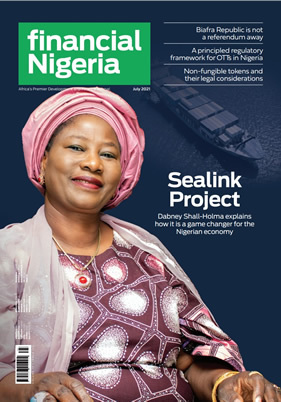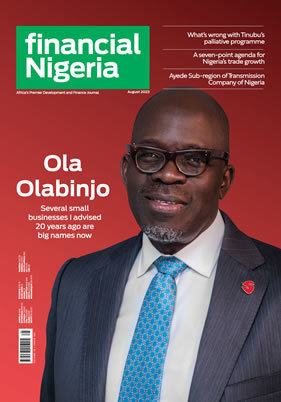
Martins Hile, Editor, Financial Nigeria magazine
Follow Martins Hile
![]() @martinshile
@martinshile
Subjects of Interest
- Governance
- SMEs
- Social Development
Social outcomes as the tail that wags climate action 12 Sep 2025
Nigeria's issuance of a N50 billion (approximately $325 million) Series III Sovereign Green Bond in June 2025 represents a significant milestone in its sustainability journey. Oversubscribed by institutional investors and supported by the Debt Management Office (DMO), Ministry of Environment, World Bank, and UK Government, the bond forms part of a broader N300 billion sustainable finance framework. According to the DMO, proceeds will fund priority projects such as climate adaptation and mitigation, clean energy transitions, and earth dams for irrigation and water conservation. Additional allocations will target water supply, rural solar power, and afforestation initiatives. But while this issuance signals continuity in Nigeria’s climate finance trajectory, it also indicates a missed opportunity.
On paper, the progress is impressive. This latest bond adds to the N25.69 billion from earlier sovereign issuances and N32.83 billion from corporate green bonds, bringing Nigeria’s total green finance to N108.51 billion since 2017, and cementing the nation’s status as Africa’s pioneer in sovereign green finance. Yet, this momentum remains starkly divorced from Nigeria's worsening social conditions. According to the International Monetary Fund (IMF), Nigeria’s GDP per capita has shrunk to $815 in 2025, down from $877 in 2024 – a 2.9% average annual decline since 2015. In real terms, the average Nigerian is poorer today than a decade ago.
As I argued in my column in the July 2025 edition of this magazine, transformative climate finance must evaluate projects based on tangible climate impact, enhanced community resilience, and inclusive economic growth. Against this backdrop, climate action devoid of social progress becomes an exercise in building infrastructure for communities whose fundamental vulnerabilities remain unaddressed.
The sectoral allocation of Nigeria's green bonds reveals a profound misalignment with Nigeria's social realities. Over 75% of the N108.51 billion raised since 2017 has targeted energy and infrastructure projects, while agriculture and water sectors – critical for the 40% food-insecure population – receive marginal attention. This bias overlooks the fact that climate variability drives droughts and floods, thereby threatening 133 million multidimensionally poor Nigerians with famine. When the vast majority of the people in the country lack basic adaptive capacity, climate investments generate limited resilience dividends regardless of their technical sophistication.
Despite the latest milestone in bond issuance, the entire green bond portfolio of the country is less than 1% of the estimated sustainable financing gap of over $80 billion annually – per a 2018 report by the United Nations Environment Programme. The ability to scale up climate investment is hindered by fiscal constraints in an economy that is half of its 2015 size. Nigeria's nominal GDP stands at $242.64 billion in 2025 (per IMF projection), a fraction of the $493 billion ten years ago, reflecting a lost decade of devaluation and stagnation. This diminished scale amounts to the widening of the climate finance gap from 16% of GDP in 2015 to 33% today – an unsustainable deficit that could perpetuate underinvestment in resilience.
Nigeria’s progress toward the Sustainable Development Goals (SDGs) by 2030 paints a sobering picture: the country is on track in roughly one-third of targets, stagnant in another third, and regressing in the rest. Without adequate financing to drive social development, the nation risks remaining trapped in poverty even as climate crises intensify. In this context, sustainable finance cannot remain a siloed environmental agenda; it must become a central pillar of social policy. When green investments deemphasise job creation, health outcomes, and food security, they fail to build the foundational resilience that communities need to withstand climate and other systemic shocks.
The shortcomings in Nigeria’s climate finance architecture are not incidental; they result from a lack of inclusivity. The market is overwhelmingly dominated by pension funds, which account for 91% of participation, while retail investors and civil society actors contribute less than 5%. This imbalance stands in clear contrast to Kenya’s mobile-platform green bonds, which achieved 22% individual investor participation, democratising access to climate solutions and fostering broader ownership.
Governance failures under the Tinubu administration have further compounded these structural issues. The overlapping mandates of the Presidential Committee on Climate Action and Green Economic Solutions (P-CAGE) continue to undermine the statutory authority of the National Council on Climate Change (NCCC). This bureaucratic bottleneck dilutes accountability, breeds inefficiency, and stifles the technocratic execution essential for effective project delivery.
The lack of leadership stability at NCCC with the recent dismissal of the commission’s Director-General, Nkiruka Maduekwe, in August 2025 – and her replacement with Omotenioye Majekodunmi – highlights the system’s political fragility. Majekodunmi is the third DG to hold the position since 2022, a development that erodes the trust vital for long-term investor confidence and community engagement.
Furthermore, impact reporting – a crucial requirement in climate finance – remains woefully inadequate. Fewer than two-thirds of green bond-funded projects undergo independent verification, and even fewer track social metrics such as job creation, skills transfer, or community resilience. This has led to what might be called infrastructure without impact: solar farms disconnected from local technical ecosystems, irrigation systems that bypass smallholder farmers, and adaptation projects that fail to build the capacities communities need to withstand future shocks.
The Social Progress Index (SPI) empirically demonstrates why these issues matter. For instance, countries with stronger social indicators are less vulnerable to climate disruption. Nigeria’s weak SPI scores amplify its exposure to climate risk, not because of geography alone, but because social deficits, including poverty, poor health systems, and limited education, worsening environmental hazards. Rather than treating social outcomes as byproducts of climate action, policymakers must recognise social progress as the foundation upon which climate resilience depends. This requires evaluating climate projects not merely for carbon mitigation potential or energy generation capacity, but also for their contributions to enhancing social metrics.
Examples of such integrated approach can be seen in climate-smart agricultural extension services that empower farmers while improving food security; solar microgrids that power health clinics and schools while training local technicians for maintenance and expansion; and flood barriers designed through community participation that enhance resilience while creating employment opportunities for vulnerable populations.
To operationalise this shift, transparency and accountability needs to be embedded into the DNA of Nigerian institutions responsible for the deployment of climate action. This entails publishing quarterly impact dashboards that track both environmental and social outcomes, and enabling citizen-led audits of project delivery. The subnational financing of state-level initiatives through matching grants to states should ensure that local voices shape implementation and that adaptation is contextually grounded. Market instruments also require innovation to mobilise diaspora capital while democratising access for ordinary Nigerians.
As Nigeria prepares for 2025 United Nations Climate Change Conference, or Conference of the Parties of the UNFCCC (or COP30), taking place in November in Belém, Brazil, the stakes are high. The summit’s focus on a New Collective Quantified Goal (NCQG) and adaptation finance presents a rare alignment of global priorities with Nigeria’s domestic needs. Carbon market activation, under the 2024 National Carbon Market Activation Policy (NCMAP), could unlock billions of naira for the country. But without strategic leadership, Nigeria risks another missed opportunity at a high-level gathering of international policymakers and market participants without securing tangible gains.
To avoid this, the country needs to adopt a new climate finance compact, one that is inclusive, prioritises social outcomes, and redefines success. Climate finance must be judged not by the number of solar panels installed, but by the number of lives improved. Not by the size of the bond issuance, but by the depth of resilience it builds. In this paradigm, technical infrastructure is the dog. Social progress – jobs, health, equity – is the tail that must wag it.
As Nigeria contends with its economic decline and rising climate vulnerability, the choice is unambiguous: continue down a path of fragmented, symbolic interventions, or embrace a transformative model that integrates climate action with human development. The 2025 green bond may be a milestone. But unless it charts a new direction, it risks becoming a monument to missed potential. By placing social progress as the metric of success, Nigeria can rewrite its climate finance story from one of exclusion and fragility to one of resilience, inclusion, and shared prosperity.
Martins Hile is a sustainability strategist and editorial consultant.
Latest Blogs By Martins Hile
- Social outcomes as the tail that wags climate action
- Lessons for Nigeria's climate finance strategy
- Rethinking Nigeria's development for people-centred outcomes
- Nigeria's economic prospects in a changing world order
- Naira commoditisation as CBN's cashless policy flaw



